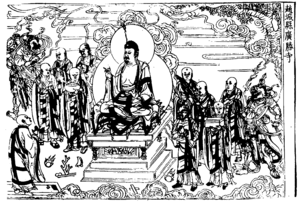Zhaocheng Jin Tripitaka
Appearance

The Zhaocheng Jin Tripitaka (Chinese: 趙城金藏) is a Chinese copy of the Buddhist canon dating from the Jin dynasty (1115–1234).
The Jin Tripitaka was originally created at the Tianning Temple around 1149, funded by donations from a woman named Cui Fazhen and her followers.[1] It was presented by Kublai Khan to the Guangsheng Temple in Pingyang, where it was rediscovered in 1933.[2] Since the Guangsheng Temple is located in Zhaocheng, the document was renamed the Zhaocheng Jin Tripitaka.[1]
With around 7,000 chapters, it is the longest extant printed work of the Jin dynasty.[3] It contains a number of sutras which are missing from subsequent editions of the canon.[1]
References
- ^ a b c Cui, Fazhen (1149). "The Zhaocheng Jin Tripitaka". World Digital Library (in Chinese). Shanxi Sheng, China. Retrieved 28 May 2013.
- ^ Asia Society; Chinese Art Society of America (2000). Archives of Asian art. Asia Society. p. 12. Retrieved 28 May 2013.
- ^ Luo Shubao (1998). Illustrated history of printing in ancient China. Wenwu Publishing House. p. 64. ISBN 978-7-5010-1042-4.
